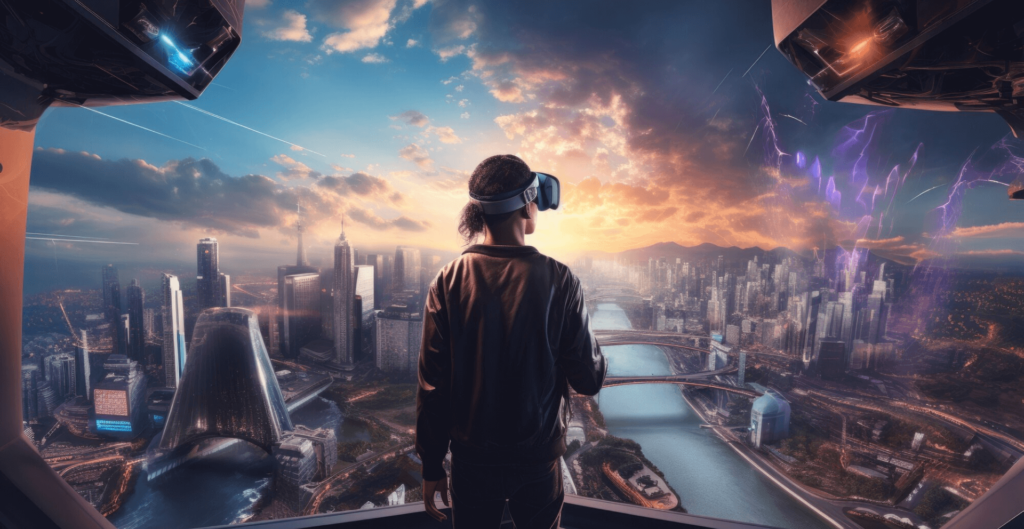
The rise of remote work has transformed the way we approach our professional lives, and Virtual Reality (VR) is at the forefront of this revolution. By creating immersive and interactive environments, VR is enhancing remote work and collaboration in ways that traditional tools cannot match. In this blog, we’ll explore how VR is reshaping the landscape of remote work and making collaboration more effective and engaging.
Immersive Virtual Workspaces
Simulating Physical Offices
Virtual Reality allows remote workers to step into a simulated office environment, complete with virtual desks, meeting rooms, and collaborative spaces. These virtual workspaces recreate the sense of presence and interaction that is often missing in remote work setups. By simulating physical offices, VR helps bridge the gap between remote and in-office experiences, making remote work more engaging and productive.
Customizable Environments
VR workspaces can be customized to suit the needs of different teams and projects. Whether it’s a brainstorming session in a virtual conference room or a quiet space for focused work, VR allows users to create environments that enhance productivity and collaboration. Customizable environments ensure that remote teams can work in spaces tailored to their specific needs, leading to more efficient and effective workflows.
Enhanced Collaboration Tools
Real-Time Interaction
One of the most significant advantages of VR in remote work is the ability to interact with colleagues in real-time. Unlike video conferencing, which can feel impersonal and detached, VR enables users to collaborate as if they were in the same room. Virtual avatars, spatial audio, and hand-tracking technology create a sense of presence and immediacy, making discussions and brainstorming sessions more dynamic and interactive.
Collaborative Visualization
VR offers powerful tools for collaborative visualization, allowing teams to work together on complex projects in a shared virtual space. Whether it’s a 3D model, a design prototype, or a data visualization, VR enables users to manipulate and explore visual content collaboratively. This hands-on approach to problem-solving enhances understanding and fosters creativity, leading to better project outcomes.
Training and Skill Development
Virtual Training Programs
Remote work often requires employees to acquire new skills and adapt to new tools. VR offers immersive training programs that can be accessed from anywhere, providing employees with hands-on learning experiences. From technical training to soft skills development, VR training programs are highly effective in delivering engaging and impactful education.
Simulations and Practice
For complex tasks that require practice and precision, VR simulations provide a safe and controlled environment for skill development. Remote workers can practice procedures, run through scenarios, and hone their skills without the risk of real-world consequences. This practical approach to learning ensures that employees are well-prepared and confident in their roles.
Breaking Down Geographic Barriers
Global Collaboration
VR removes the limitations of geography, allowing teams from around the world to collaborate seamlessly. Virtual meetings, conferences, and collaborative projects can be conducted in a shared virtual space, eliminating the need for travel and reducing time zone constraints. This global connectivity fosters diversity and inclusion, bringing together talents and perspectives from different parts of the world.
Remote Recruitment and Onboarding
Virtual Reality is also transforming the recruitment and onboarding process for remote teams. Employers can conduct virtual interviews, showcase company culture through immersive experiences, and provide comprehensive onboarding programs in VR. This streamlined approach to hiring and onboarding ensures that new employees feel connected and supported, even when working remotely.
Conclusion
Virtual Reality is revolutionizing remote work and collaboration by creating immersive, interactive, and engaging experiences. From virtual workspaces and enhanced collaboration tools to immersive training programs and global connectivity, VR is making remote work more efficient and enjoyable. As VR technology continues to evolve, its impact on remote work will only grow, offering new opportunities for innovation and productivity. Embracing VR in remote work is a step towards a more connected, collaborative, and dynamic future of work.


